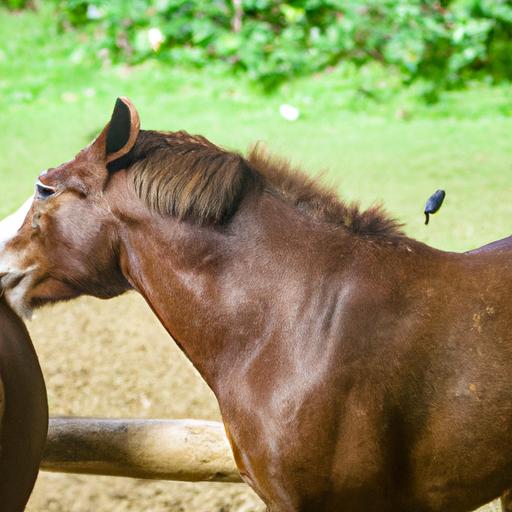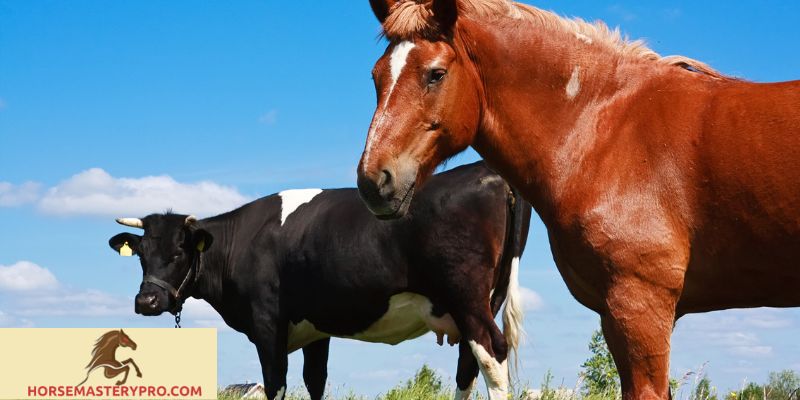Unlock the secrets of horse naughty behavior! Learn to identify signs, differentiate from normal behavior, and address issues for a harmonious partnership.
Introduction

As horse enthusiasts, we all know that horses possess unique personalities and behaviors that make them such fascinating creatures. However, sometimes our equine friends can exhibit naughty behavior that disrupts our harmony with them. In this article, we will delve into the intriguing world of horse behavior and explore the phenomenon of horse naughty behavior. By understanding the root causes, identifying the signs, and implementing effective management strategies, we can foster a more harmonious relationship with our horses.
Overview of Horse Behavior
Horses are sentient beings with complex instincts and social dynamics. They communicate through body language, vocalizations, and subtle cues. Understanding their natural behavior is crucial in comprehending why they may exhibit naughty behavior. Horses are herd animals, valuing social interactions and establishing hierarchies within their groups. Their survival instincts drive them to be alert and reactive to their environment.
Introduction to Horse Naughty Behavior
Horse naughty behavior refers to any actions or conduct displayed by horses that deviate from expected or acceptable behavior. This can range from minor annoyances such as nipping or pawing to more serious issues like bucking, biting, or spooking. Naughty behavior can occur due to various factors, including fear, lack of training, improper handling, health issues, or even boredom.
Naughty behavior not only poses risks to our safety but can also hinder our progress and enjoyment with our horses. It is crucial to address these behaviors promptly and effectively to ensure a harmonious partnership. In the following sections, we will explore the identification and management of horse naughty behavior, as well as preventative measures to foster a positive and mutually beneficial relationship with our equine companions.
Stay tuned to learn how to decipher the signs of horse naughty behavior and gain valuable insights into managing and preventing these behaviors. Together, we can unlock the secrets to a fulfilling and rewarding partnership with our horses.
Next Section: Understanding Horse Naughty Behavior
Understanding Horse Naughty Behavior
Definition of Horse Naughty Behavior
Before we delve deeper into the world of horse naughty behavior, let’s establish a clear definition. Horse naughty behavior refers to actions or behaviors exhibited by horses that deviate from expected or acceptable conduct. These behaviors can range from minor annoyances to potentially dangerous actions, which may include biting, kicking, rearing, bucking, or refusing to cooperate. It is essential to differentiate between naughty behavior and normal horse behavior, as understanding the distinction is crucial for effective management.
Common Causes of Horse Naughty Behavior
To address horse naughty behavior, we must first understand the underlying causes. Numerous factors contribute to the development of these behaviors, including:
- Fear and Anxiety: Horses may exhibit naughty behavior when they feel threatened or anxious. This can be triggered by unfamiliar environments, loud noises, or even past traumatic experiences.
- Lack of Training: Insufficient or improper training can result in a horse behaving naughtily. A lack of clear boundaries and consistent expectations can lead to confusion and frustration for both the horse and the handler.
- Pain or Discomfort: Horses may display naughty behavior as a response to pain or discomfort caused by underlying health issues, ill-fitting tack, or dental problems. It is vital to rule out any physical discomfort as a potential cause.
- Boredom and Lack of Stimulation: Horses are intelligent animals that require mental and physical stimulation. Without adequate exercise, social interaction, or mental enrichment, they may resort to naughty behavior as a means of alleviating boredom.
Impact of Naughty Behavior on Horse and Rider Safety
The consequences of horse naughty behavior can be significant for both the horse and the rider. Naughty behavior puts the safety of both parties at risk and can result in injuries or accidents. Moreover, consistent naughty behavior can erode the trust and bond between the horse and the rider, hindering progress and enjoyment in their partnership.
By understanding the definition, causes, and impact of naughty behavior, we can begin to address and manage these behaviors effectively. In the next sections, we will explore techniques for identifying and managing horse naughty behavior, as well as strategies for preventing these behaviors from arising in the first place.
Next Section: Identifying Horse Naughty Behavior
Managing Horse Naughty Behavior
As responsible horse owners and riders, it is our duty to effectively manage and address naughty behavior in our equine companions. By implementing appropriate training techniques and seeking professional guidance when necessary, we can create a safe and enjoyable environment for both horse and rider.
A. Establishing a Consistent Training Routine
Consistency is key when it comes to managing horse naughty behavior. Establishing a structured and regular training routine helps horses understand boundaries, expectations, and consequences for their actions. Consistency in your approach and cues will provide clarity and help your horse comprehend what is expected of them. Ensure that you set aside dedicated time for training, focusing on reinforcing desired behaviors and discouraging naughty behavior.
B. Implementing Positive Reinforcement Techniques
Positive reinforcement is a powerful tool in managing horse naughty behavior. By rewarding desired behaviors, we encourage our horses to repeat them, reinforcing the idea that good behavior leads to positive outcomes. This can be done through verbal praise, treats, or even a pat on the neck. Remember to deliver rewards promptly and consistently, linking them directly to the desired behavior to ensure clear communication with your horse.
Conversely, it is essential to avoid using punishment or harsh methods when dealing with naughty behavior. Punishment can lead to fear and anxiety, damaging the trust and bond between horse and rider. Instead, focus on redirecting and rewarding good behavior while calmly and assertively addressing any unwanted actions.
C. Seeking Professional Help for Severe Cases
In some instances, horse naughty behavior may persist despite consistent training efforts. This is when seeking professional help becomes crucial. An experienced trainer or equine behaviorist can provide valuable insights and specific strategies tailored to your horse’s unique needs. They can evaluate the root causes of the behavior and work with you to develop a customized training plan to address and modify the naughty behavior effectively.
Remember, each horse is an individual, and what works for one may not work for another. Professional guidance can make a significant difference in managing severe cases of naughty behavior and ensuring the safety and well-being of both horse and rider.
Stay tuned for the next section, where we will explore preventative measures to minimize horse naughty behavior and establish a strong and positive bond with your equine partner.
Next Section: Preventing Horse Naughty Behavior
Preventing Horse Naughty Behavior
As the saying goes, “prevention is better than cure.” When it comes to horse naughty behavior, taking proactive measures to prevent such behaviors from arising in the first place is paramount. By implementing proper horse care and management techniques, building a strong bond based on trust and respect, and providing regular exercise and mental stimulation, we can set our equine companions up for success.
A. Proper Horse Care and Management Techniques
Maintaining a healthy and well-rounded lifestyle for your horse is essential in preventing naughty behavior. Ensure your horse receives a balanced diet that meets their nutritional needs. A diet that lacks essential nutrients or is overly rich in sugars and starches can contribute to behavioral issues. Additionally, provide ample access to fresh water and forage throughout the day.
Establish a consistent routine for feeding, turnout, and exercise. Horses thrive on predictability and routine, reducing stress and anxiety that can lead to naughty behavior. Provide a safe and comfortable living environment, with appropriate shelter, clean bedding, and secure fencing.
Regular grooming sessions not only keep your horse looking their best but also promote bonding and relaxation. Take the time to groom your horse, paying attention to their body language and addressing any discomfort or tension you may observe.
B. Building a Strong Bond with the Horse through Trust and Respect
Building a strong bond with your horse is crucial in preventing naughty behavior. Spend quality time with your horse, engaging in activities that foster trust and respect. Develop a consistent and fair training approach using positive reinforcement techniques.
Take the time to understand your horse’s individual needs and preferences. Each horse is unique, and by listening to their cues and responding appropriately, you can cultivate a deeper connection. Approach training with patience and empathy, allowing your horse to learn at their own pace.
C. Providing Regular Exercise and Mental Stimulation
Just like humans, horses benefit from regular exercise and mental stimulation. A lack of physical activity and mental engagement can lead to boredom, restlessness, and the manifestation of naughty behavior. Incorporate a variety of activities into your horse’s routine, such as trail rides, groundwork exercises, or obstacle courses.
Consider introducing toys or puzzles that provide mental stimulation, such as treat-filled balls or hanging objects. Rotate their turnout areas or provide access to different environments to keep things interesting for them.
By prioritizing proper horse care, building a strong bond based on trust and respect, and providing regular exercise and mental stimulation, you can significantly reduce the likelihood of your horse exhibiting naughty behavior.
Next Section: Conclusion
Conclusion
In conclusion, understanding and managing horse naughty behavior is a crucial aspect of developing a strong and harmonious bond with our equine companions. By recognizing the signs and indicators of naughty behavior, we can intervene early and address any underlying issues. Differentiating between normal horse behavior and naughty behavior is essential to avoid misinterpretations.
Early detection and intervention play a vital role in preventing the escalation of naughty behavior and ensuring the safety of both horse and rider. It is crucial to establish a consistent training routine and implement positive reinforcement techniques to manage and correct naughty behavior effectively. Seeking professional help when dealing with severe cases can provide valuable guidance and expertise.
Prevention is always better than cure. By providing proper horse care, building trust and respect through a strong bond, and offering regular exercise and mental stimulation, we can minimize the occurrence of naughty behavior in our horses. Remember, a well-rounded and contented horse is less likely to exhibit disruptive behavior.
At Horsemasterypro.com, we are dedicated to providing you with expert advice and resources to enhance your horsemanship skills. By utilizing the knowledge gained from this article, you can embark on a journey towards a mutually rewarding partnership with your horse.
Remember, understanding and addressing naughty behavior is an ongoing process. With patience, consistency, and a deep understanding of your horse’s unique personality, you can overcome any challenges and build a strong foundation of trust and cooperation.
So, let’s embrace the adventure of understanding horse naughty behavior and embark on a remarkable journey with our equine friends.
Stay tuned for more insightful articles and resources at Horsemasterypro.com, where we nurture the true potential of horse and rider.
words)


